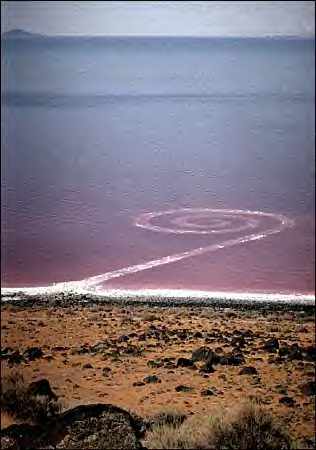
Robert Smithson: Spiral Jetty, 1970.
SAVING THE JETTY
Robert Smithson’s Spiral Jetty, thanks to drought, is above water level again after nearly 30 years. It’s covered with salt crystals. Should it be rebuilt? The DIA Foundation, its owner, is considering some sort of restoration. The New York Times of January 13 in an article on the Spiral Jetty, as is its custom, covered all sides of the argument.
The Spiral Jetty, composed of basalt rocks, forms a fiddle-head roadway out from the shore of Utah’s Great SaltLake at Rozel Point. Smithson’s wife, artist Nancy Holt, thinks it should be built up again, and apparently the artist himself, before he died in a plane crash in 1973, gave an interview indicating preservation of his Earth Art might be in order.
I knew Smithson. I think he was a friend. Alice Neel, sometimes referred to as the catcher of souls, painted Smithson before he was famous. She called him The Wolf Boy. But he had many enemies too. The Smithson section of Amy Newman’s all-too revealing Challenging Art: Artforum 1962-1974, now in paperback from Soho Press, shows how nasty some critics once featured in Philip Leider’s magazine could really be. Suspicions confirmed: what a group.
But, as far as I know, I was the first art critic to write about Smithson. I covered an early non-site. That was his term for bits of the landscape dragged into Virginia Dwan’s New York gallery as rocks in bins or on the floor with mirrors or sometimes just as photographs. Traditional sculptors liked to bring some art into the landscape; Smithson once said he liked to bring a little bit of the landscape indoors. There’s more to Smithson than the Spiral Jetty.
So I tramped with him around the remains of an old quarry right up against the Jersey Turnpike on a promontory overlooking the Meadowlands. Holt did the driving and took the photographs. This was, believe it or not, for New York Magazine.
Was he really a friend? Let’s put it this way. I enjoyed arguing with him. I appreciated his dark vision, his sarcasm and his talent. Spiral Jetty was indeed his masterpiece. And, just as important, the masterpiece of Earth Art. I lost interest when he began proposing earthworks to mining companies so they could beautify their open pits and depleted strips.
My own feeling is that such scars should be left as they are, as reminders, as symbols of desecration and greed. Be that as it may, I myself am much taken by the gorgeous Lavender Pit in Bisbee, Arizona, a deep wound in the name of copper. It should never be filled in. It is part of history.
Nature, given half a chance, will always retake the land. Or like the manmade Great Plains, huge parts of the Sonoran Desert, and Viking-deforested Iceland, these newer landscapes will themselves become nature. We are not separate from nature. We are nature, not only in tooth and claw, but also with bulldozer and plow.
I know the DIA Foundation has good intentions, but isn’t Smithson’s notion of entropy, in both its aesthetic and philosophical dimensions, more important than trying to imitate the way the Spiral Jetty looked in 1970? Entropy, in Smithson’s preferred meaning, has been defined by one dictionary as “the degradation of matter and energy in the universe to an ultimate state of inert uniformity.” Smithson had a liking for science fiction of the cosmological kind. Things fall apart. Chaos rules. Matter becomes one large lump, frozen in endless space. One could save the Spiral Jetty, but in the process lose the poetry.
To see the Spiral Jetty now, why not look from a satellite?
We could, of course, have a Spiral Jetty Theme Park. We art tourists could buy helicopter shots of ourselvessprinting on the Jetty, just as Smithsonran in his movie. The glossy photos would be ready and waiting upon our return to the new resort hotel down the road. We have long been able to buy shots of ourselves white-water rafting. Instant photos in several sizes are spread out downstream on the banks of almost any Colorado river. I have one such photo; I once used it as a screensaver. Now I yearn to see John Perreault running on the Spiral Jetty! After all, I too like the desert. Smithson, no stranger to irony, might have enjoyed the socialization of his great work as yet another example of entropy.
